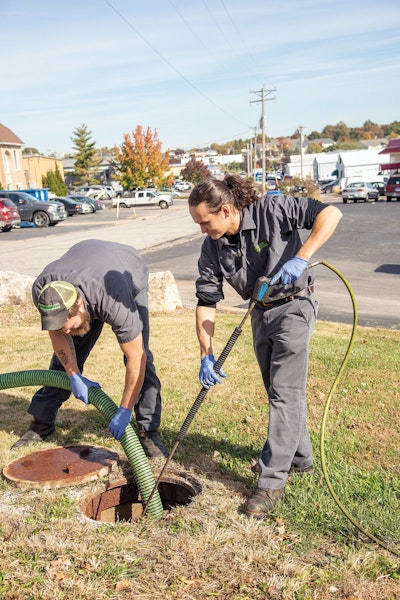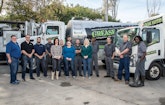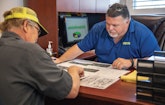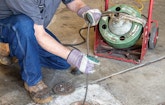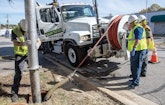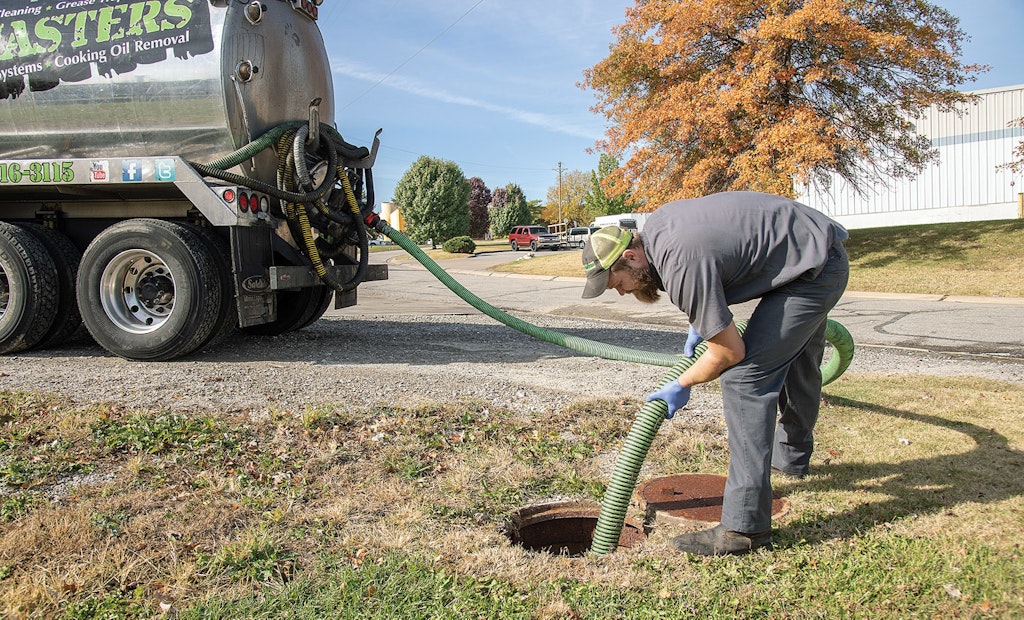Interested in Cleaning?
Get Cleaning articles, news and videos right in your inbox! Sign up now.
Cleaning + Get AlertsCleaning exhaust hoods in commercial kitchens may not sound like a promising starting point for building a multimillion-dollar business. But that’s exactly how Grease Masters got its start.
The company, based in suburban St. Charles, Missouri, is the definition of a full-service, well-diversified business — it pumps out grease traps, collects and recycles cooking oil, and cleans and inspects sewers in and around the St. Louis metro area. It even does a bit of hydroexcavation and plumbing work. How owners John and Pam Remstedt parlayed cleaning exhaust hoods into a thriving, multipronged business vividly illustrates how one service leads to another. It also underscores the importance of paying attention to customers’ needs and taking calculated risks to invest in technologically advanced equipment.
“We pretty much followed a classic blueprint for building a diversified business,” says John Remstedt, age 55. “Diversity is one key to our success, along with our team members and the business relationships we’ve built. All three go hand in hand. But it all starts with employees. As (billionaire businessman) Richard Branson once said, worry about your employees first, because if you take care of your employees, they’ll take good care of your customers.”
Today, cleaning kitchen exhaust hoods in restaurants, corporations, and institutions such as nursing homes, schools and hospitals remains a staple service, generating about 40 percent of the company’s gross revenue. Cleaning grease traps contributes another 25 percent and sewer cleaning kicks in another 10 percent. The balance stems from collecting and recycling cooking oil (yellow grease), plumbing work and other miscellaneous services.
Moreover, the company consistently increases revenue by 10 to 15 percent annually. “I attribute that to good customer service and our team members,” Remstedt says. “They just do what they know how to do and do it properly.”
Spotting opportunity
Ironically enough, Grease Masters wouldn’t exist if not for a failed business partnership. Remstedt started his career by working for a portable restroom rental outfit in St. Louis that also cleaned grease traps in winter to minimize offseason layoffs. Later, he formed a grease trap cleaning business with a friend.
But things headed south when the friend left and was replaced by two other investors. The new partnership didn’t go well, and Remstedt eventually was ousted from the company — with a three-year noncompete agreement. As he considered how to reinvent his career, Remstedt had an epiphany as a pumper truck passed by him as he was driving one day.
“I saw that truck and thought to myself, ‘Why not go back to what you know?’”
Since the noncompete agreement prevented him from cleaning grease traps, Remstedt shrewdly started cleaning restaurant kitchen exhaust hoods instead. That allowed him to maintain relationships with his old restaurant customers.
The business was attractive because barriers to entry were low: fairly minimal startup costs coupled with a required one-week certification class sponsored by the International Kitchen Exhaust Cleaning Association.
When Remstedt’s noncompete agreement expired, he used his existing restaurant connections to jump-start his grease trap pumping aspirations. In fact, exhaust hood cleaning still effectively generates demand for other company services.
“Hood cleaning was our staple business for our first three years, and it still gets us in a lot of places because it’s hard work and not everyone does it well,” Remstedt says. “So we generate a lot of ancillary business from that. It helps us get our foot in the door so we can offer higher-margin services like grease trap pumping and sewer line cleaning.”
Success factors
One thing that helps the company’s profit margins is reasonable grease disposal rates. It’s a bonus that the St. Louis municipal treatment plant even accepts grease waste when so many facilities nationwide no longer do so; its disposal rate of 8 cents a gallon only sweetens the deal. “We’re very fortunate,” he says. There’s also a rendering plant in St. Louis that accepts grease.
Cleaning lines thoroughly is another strong factor in the company’s success. Remstedt disdains what he calls “pop-and-gos” or “show-and-gos,” where grease trap cleaners come in, jet a line once, and leave.
“You can’t run the lines just one time,” he emphasizes. “You can’t come in and half-ass this stuff because it’ll turn around and bite you quickly. You have to clean the lines, inspect them, and then clean them again if needed. Our guys are required to camera every line they flush. It not only proves to customers that we did the job we said we’d do, but we also don’t leave any debris behind.
“An inspection camera is a big part of making sure what we do is done properly. So I suggest investing in a good camera system.”
For drain cleaners interested in cleaning grease traps, Remstedt also recommends developing good relationships with inspectors. “Do good work and make friends with them. Be polite and be courteous and develop a level of respect with them. … And do what they tell you to do. If you keep the regulators happy, they’ll leave your customers alone.”
Maintenance demands
The company’s Vac-Con PD 4212 combination vac truck is perhaps the most tangible symbol of the company’s fastest-growing business segment: maintenance agreements to clean and inspect municipal assets. The company broke into that market in 2013 when officials from a local sewer district asked if Grease Masters could clean and maintain roughly 250 lift stations.
“It was a logical extension to what we already were doing,” Remstedt says.
Grease Masters also recently won a three-year contract to clean wet wells owned by the Metropolitan St. Louis Sewer District, as well as perform maintenance work at the district’s wastewater treatment plant.
Most of the company’s grease trap and exhaust hood customers sign maintenance agreements, motivated by the fact that regularly scheduled cleanings are more cost-effective than emergency calls that can happen at the worst possible time and disrupt business. Remstedt says maintenance agreements allow the company to better plan for manpower and equipment needs, plus it makes cash flow more consistent than relying on emergency work.
But maintenance contracts also can impose more demands on equipment and employees. For instance, the sewer district’s maintenance contract comes with emergency callout guidelines that Grease Masters has to be ready to fulfill. That means arriving at a job site with the required equipment within two hours after receiving an emergency call (three hours on a weekend). The company’s full roster of equipment enables it to comply with such requirements, he says.
“We need to be there within the prescribed time limit, no matter what we’re doing or what time it is,” Remstedt says. “And one reason we win contracts is because we’re equipped to do that.”
Maintenance agreements aside, restaurants are more prone to failure than most businesses. “At times, it’s not the most stable customer base,” he concedes. As such, the company pays close attention when customers postpone scheduled maintenance and takes quick action when they miss payments.
“Cleaning grease traps and hood vents is the last (service) to come in and the first thing to go when a business is struggling,” Remstedt explains. “So when customers say they’re going to push back their scheduled service a bit by one or two months, we know they’re struggling.
“We pay attention to that and make them COD (cash on delivery) customers and tighten up our credit lines with them. And if they’re on a recurring-service plan, we won’t service the account if they didn’t pay their last bill. We have to be careful so we don’t get stuck.”
Room to grow
Remstedt believes that the company’s double-digit revenue growth is sustainable. In fact, he foresees further growth even though his two-person sales staff no longer does cold calls — a reflection of strong word-of-mouth referrals. “We still look on the internet for bids, but we’re just not out knocking on doors anymore.”
The entrepreneur also has no plans to expand geographically, noting that it’s difficult to compete with other companies outside of a 100-mile radius around St. Louis because of the added costs for fuel, labor and other transportation-related expenses. “Nobody wants to pay the freight,” he says. “And logistically, it just doesn’t make sense.”
The way Remstedt sees it, there still are plenty of existing customers that eventually might require some of the ancillary services that Grease Masters can provide. Grease trap customers, for instance, might need sewer jetting and inspection services, and municipalities that use the company for sewer cleaning might need hydroexcavating. So cross-promotion between service sectors can definitely lead to more revenue growth.
Plus, there are still thousands of metro-area restaurants that don’t use Grease Masters to pump their grease traps. “We have a lot of accounts, but there are 12,000-some restaurants in the St. Louis area,” he says. “And we don’t have all of them as customers.”
Equipped for everything
Offering a wide array of services requires a vast fleet of equipment to ensure you can handle any job. Grease Masters has all the bases covered.
“Customers want one guy who can do it all and take care of everything,” says John Remstedt, owner. “That’s something we pride ourselves on. … You never want to have to tell a customer, ‘No, I can’t do that.’ If you do, they’ll go find someone else.”
To service grease traps, Grease Masters relies on a 250-gallon grease trap vacuum trailer made by Dyna-Vac Equipment, featuring a Masport pump system. For customers with less-accessible traps, the company owns three 55-gallon wheeled Dyna-Lite mini-vac pumping systems, also made by Dyna-Vac Equipment.
The company owns a 2005 Mack truck equipped with a 4,000-gallon steel tank, built by National Truck Center; it’s equipped with a full-tilt bed, a 150-gallon water tank, and a waterjetting system (4 1/2 gpm at 3,000 psi) made by Advance Pump & Equipment with a Jurop/Chandler vacuum pump. In addition, Dyna-Vac Equipment built out a 2010 Ford F-550 with a 700-gallon waste and 300-gallon freshwater aluminum tank, a Masport vacuum pump, and a water pump built by General Pump (12 gpm at 3,000 psi). The truck is used to jet sewer lines and pump out bins placed outside facilities to collect used cooking oil. The company also owns about 100 oil-collection bins made by Wastequip, ranging from 100- to 300-gallons.
Grease Masters also invested in two Peterbilt 348 trucks for cleaning grease traps and collecting used cooking oil. Each unit was built out by Satellite Industries with a 4,000-gallon aluminum tank by Imperial Industries, a 100-gallon water tank and a water pump/jetter system made by Advance Pump & Equipment (5 gpm at 3,000 psi). One truck has a National Vacuum Equipment 4310 blower (940 cfm), and the other has an National Vacuum Equipment Challenger 866 vacuum pump (520 cfm).
To clean drainlines, Grease Masters owns four Spartan 100 cable machines made by Spartan Tool, three cable machines made by Electric Eel, two RIDGID SeeSnake inspection camera systems, and three Super-Vee hand-held drain cleaning machines manufactured by General Pipe Cleaners/General Wire Spring.
The company also relies on two other trucks for cleaning sewers. One is a 2015 Isuzu NPR equipped with a VT Hackney/Hackney box body and a water jetter made by US Jetting, featuring two 100-gallon water tanks and a hydraulically driven pump (10 gpm at 3,100 psi); the other is a Nissan National Vacuum Equipment van that primarily carries Spartan Tool and Electric Eel drain machines.
The heavy hitter in the group is a Vac-Con PD 4212 combination vacuum truck built on a 2013 Freightliner 114SD chassis. The unit features a 12-cubic-yard steel debris tank, a 1,300-gallon water tank, a blower (5,800 cfm) made by Howden Roots, a water pump (80 gpm at 2,000 psi) made by Giant Industries, a 20-foot boom that swings 270 degrees and a hydroexcavating package.
Two 24-foot box trucks used to carry hood- and sewer-cleaning equipment round out the fleet. Each truck is rigged up with a 600-gallon steel slide-in tank made by Dyna-Vac Equipment, a Masport vacuum pump (250 cfm) and a hot-water jetting system made by Mi-T-M (10 gpm at 3,000 psi).
The key to repeat business
Like so many business owners, John Remstedt credits great customer service for the success of Grease Masters, the company he co-owns with his wife, Pam, in St. Charles, a suburb of St. Louis.
“We simply do what we say we’re going to do when we say we’re going to do it,” he says. “That’s the key, and not doing that is one of the biggest problems in service industries today.”
Customer education is a critical component of customer service. For example, technicians give customers pamphlets and brochures that explain best practices for grease trap maintenance. Remstedt says he also offers kitchen managers a short training course that shows them how to avoid problems with their grease traps.
“The more educated your customer is, the better the customer you’re going to have,” he says. “A lot of people open a restaurant but don’t know what a grease trap is, why it needs to be pumped regularly or what hood vents need cleaning. They never talk about kitchen maintenance in cooking schools.”
Transparency is also important to both customers and the Remstedts, which is why they use KeepandShare photo archive software. After a grease trap or sewer line inspection, technicians upload photos to the website. Customers create a secure account that allows them to access only their photos.
“It’s more convenient because we don’t have to take time to send out photos to customers,” Remstedt explains. “And if there ever are questions about whether or not we did the work, the time- and date-stamped photos prove we actually did what we say we did. A lot of time hood cleaners come in to work at night and no one else is there, so over time, we learned to take before-and-after photos to prove we did the work.”
